Yuan Li
PathFound: An Agentic Multimodal Model Activating Evidence-seeking Pathological Diagnosis
Dec 29, 2025Abstract:Recent pathological foundation models have substantially advanced visual representation learning and multimodal interaction. However, most models still rely on a static inference paradigm in which whole-slide images are processed once to produce predictions, without reassessment or targeted evidence acquisition under ambiguous diagnoses. This contrasts with clinical diagnostic workflows that refine hypotheses through repeated slide observations and further examination requests. We propose PathFound, an agentic multimodal model designed to support evidence-seeking inference in pathological diagnosis. PathFound integrates the power of pathological visual foundation models, vision-language models, and reasoning models trained with reinforcement learning to perform proactive information acquisition and diagnosis refinement by progressing through the initial diagnosis, evidence-seeking, and final decision stages. Across several large multimodal models, adopting this strategy consistently improves diagnostic accuracy, indicating the effectiveness of evidence-seeking workflows in computational pathology. Among these models, PathFound achieves state-of-the-art diagnostic performance across diverse clinical scenarios and demonstrates strong potential to discover subtle details, such as nuclear features and local invasions.
Guiding Perception-Reasoning Closer to Human in Blind Image Quality Assessment
Dec 18, 2025Abstract:Humans assess image quality through a perception-reasoning cascade, integrating sensory cues with implicit reasoning to form self-consistent judgments. In this work, we investigate how a model can acquire both human-like and self-consistent reasoning capability for blind image quality assessment (BIQA). We first collect human evaluation data that capture several aspects of human perception-reasoning pipeline. Then, we adopt reinforcement learning, using human annotations as reward signals to guide the model toward human-like perception and reasoning. To enable the model to internalize self-consistent reasoning capability, we design a reward that drives the model to infer the image quality purely from self-generated descriptions. Empirically, our approach achieves score prediction performance comparable to state-of-the-art BIQA systems under general metrics, including Pearson and Spearman correlation coefficients. In addition to the rating score, we assess human-model alignment using ROUGE-1 to measure the similarity between model-generated and human perception-reasoning chains. On over 1,000 human-annotated samples, our model reaches a ROUGE-1 score of 0.512 (cf. 0.443 for baseline), indicating substantial coverage of human explanations and marking a step toward human-like interpretable reasoning in BIQA.
Building Reasonable Inference for Vision-Language Models in Blind Image Quality Assessment
Dec 10, 2025Abstract:Recent progress in BIQA has been driven by VLMs, whose semantic reasoning abilities suggest that they might extract visual features, generate descriptive text, and infer quality in a human-like manner. However, these models often produce textual descriptions that contradict their final quality predictions, and the predicted scores can change unstably during inference - behaviors not aligned with human reasoning. To understand these issues, we analyze the factors that cause contradictory assessments and instability. We first estimate the relationship between the final quality predictions and the generated visual features, finding that the predictions are not fully grounded in the features and that the logical connection between them is weak. Moreover, decoding intermediate VLM layers shows that the model frequently relies on a limited set of candidate tokens, which contributes to prediction instability. To encourage more human-like reasoning, we introduce a two-stage tuning method that explicitly separates visual perception from quality inference. In the first stage, the model learns visual features; in the second, it infers quality solely from these features. Experiments on SPAQ and KONIQ demonstrate that our approach reduces prediction instability from 22.00% to 12.39% and achieves average gains of 0.3124/0.3507 in SRCC/PLCC across LIVE, CSIQ, SPAQ, and KONIQ compared to the baseline. Further analyses show that our method improves both stability and the reliability of the inference process.
* Accepted to the ICONIP (International Conference on Neural Information Processing), 2025
Investigate the Low-level Visual Perception in Vision-Language based Image Quality Assessment
Dec 10, 2025Abstract:Recent advances in Image Quality Assessment (IQA) have leveraged Multi-modal Large Language Models (MLLMs) to generate descriptive explanations. However, despite their strong visual perception modules, these models often fail to reliably detect basic low-level distortions such as blur, noise, and compression, and may produce inconsistent evaluations across repeated inferences. This raises an essential question: do MLLM-based IQA systems truly perceive the visual features that matter? To examine this issue, we introduce a low-level distortion perception task that requires models to classify specific distortion types. Our component-wise analysis shows that although MLLMs are structurally capable of representing such distortions, they tend to overfit training templates, leading to biases in quality scoring. As a result, critical low-level features are weakened or lost during the vision-language alignment transfer stage. Furthermore, by computing the semantic distance between visual features and corresponding semantic tokens before and after component-wise fine-tuning, we show that improving the alignment of the vision encoder dramatically enhances distortion recognition accuracy, increasing it from 14.92% to 84.43%. Overall, these findings indicate that incorporating dedicated constraints on the vision encoder can strengthen text-explainable visual representations and enable MLLM-based pipelines to produce more coherent and interpretable reasoning in vision-centric tasks.
Echoless Label-Based Pre-computation for Memory-Efficient Heterogeneous Graph Learning
Nov 14, 2025Abstract:Heterogeneous Graph Neural Networks (HGNNs) are widely used for deep learning on heterogeneous graphs. Typical end-to-end HGNNs require repetitive message passing during training, limiting efficiency for large-scale real-world graphs. Pre-computation-based HGNNs address this by performing message passing only once during preprocessing, collecting neighbor information into regular-shaped tensors, which enables efficient mini-batch training. Label-based pre-computation methods collect neighbors' label information but suffer from training label leakage, where a node's own label information propagates back to itself during multi-hop message passing - the echo effect. Existing mitigation strategies are memory-inefficient on large graphs or suffer from compatibility issues with advanced message passing methods. We propose Echoless Label-based Pre-computation (Echoless-LP), which eliminates training label leakage with Partition-Focused Echoless Propagation (PFEP). PFEP partitions target nodes and performs echoless propagation, where nodes in each partition collect label information only from neighbors in other partitions, avoiding echo while remaining memory-efficient and compatible with any message passing method. We also introduce an Asymmetric Partitioning Scheme (APS) and a PostAdjust mechanism to address information loss from partitioning and distributional shifts across partitions. Experiments on public datasets demonstrate that Echoless-LP achieves superior performance and maintains memory efficiency compared to baselines.
MARAG-R1: Beyond Single Retriever via Reinforcement-Learned Multi-Tool Agentic Retrieval
Oct 31, 2025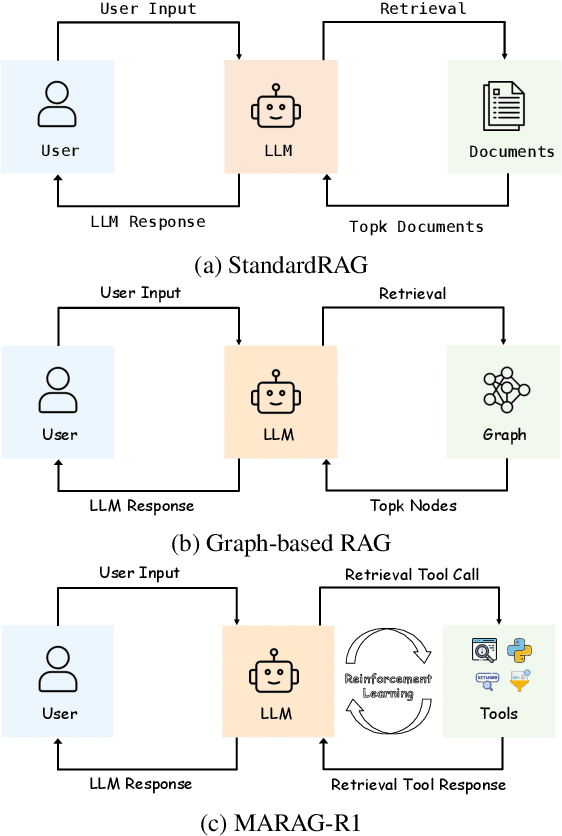
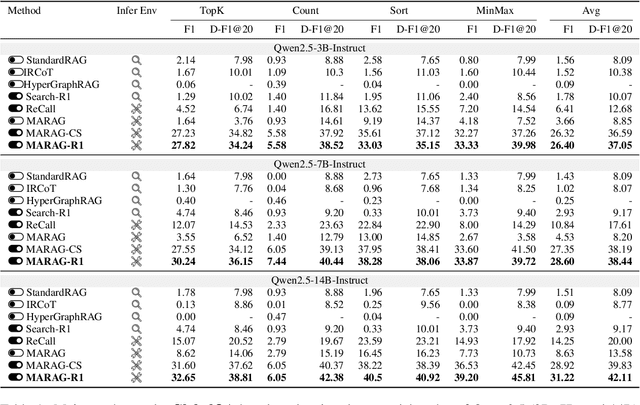
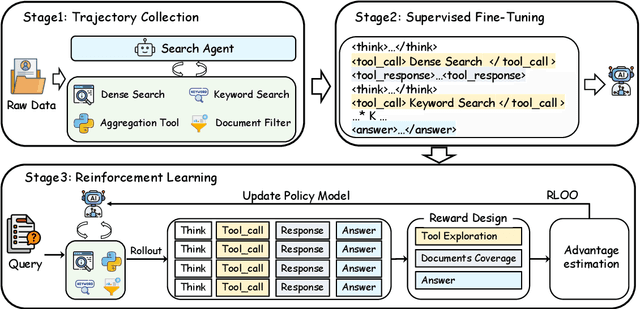
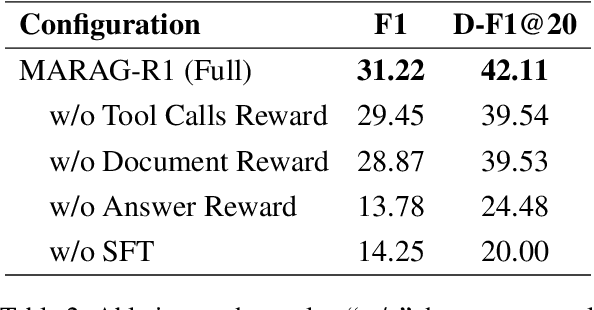
Abstract:Large Language Models (LLMs) excel at reasoning and generation but are inherently limited by static pretraining data, resulting in factual inaccuracies and weak adaptability to new information. Retrieval-Augmented Generation (RAG) addresses this issue by grounding LLMs in external knowledge; However, the effectiveness of RAG critically depends on whether the model can adequately access relevant information. Existing RAG systems rely on a single retriever with fixed top-k selection, restricting access to a narrow and static subset of the corpus. As a result, this single-retriever paradigm has become the primary bottleneck for comprehensive external information acquisition, especially in tasks requiring corpus-level reasoning. To overcome this limitation, we propose MARAG-R1, a reinforcement-learned multi-tool RAG framework that enables LLMs to dynamically coordinate multiple retrieval mechanisms for broader and more precise information access. MARAG-R1 equips the model with four retrieval tools -- semantic search, keyword search, filtering, and aggregation -- and learns both how and when to use them through a two-stage training process: supervised fine-tuning followed by reinforcement learning. This design allows the model to interleave reasoning and retrieval, progressively gathering sufficient evidence for corpus-level synthesis. Experiments on GlobalQA, HotpotQA, and 2WikiMultiHopQA demonstrate that MARAG-R1 substantially outperforms strong baselines and achieves new state-of-the-art results in corpus-level reasoning tasks.
SBS: Enhancing Parameter-Efficiency of Neural Representations for Neural Networks via Spectral Bias Suppression
Sep 09, 2025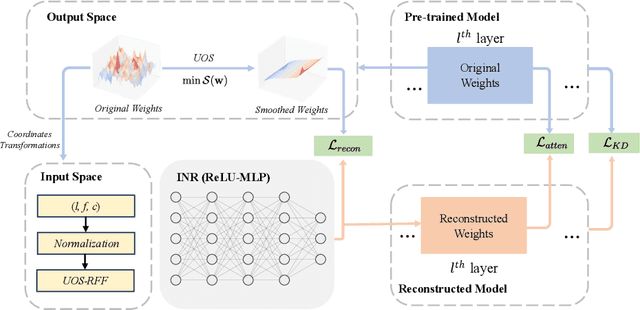
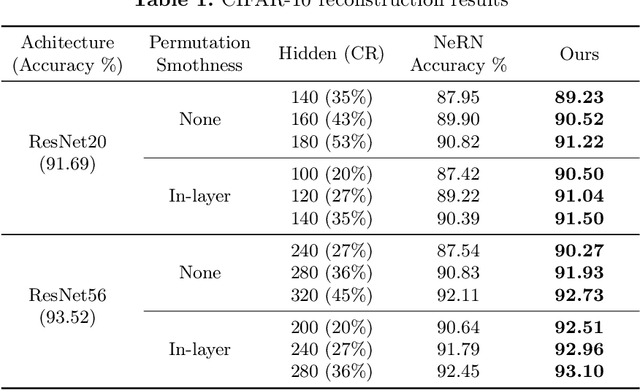
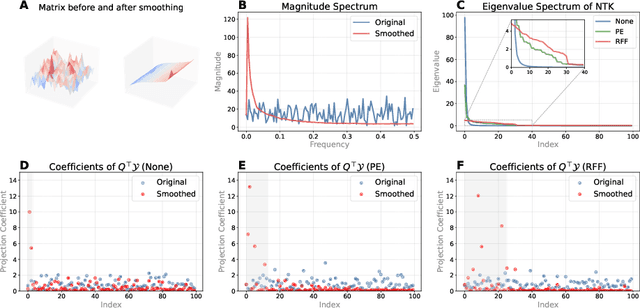
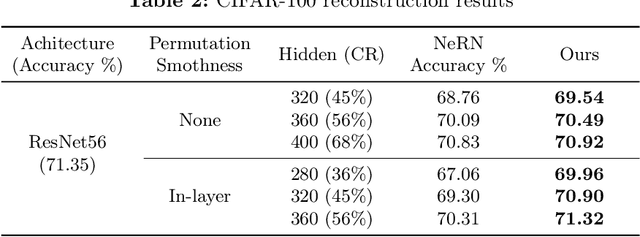
Abstract:Implicit neural representations have recently been extended to represent convolutional neural network weights via neural representation for neural networks, offering promising parameter compression benefits. However, standard multi-layer perceptrons used in neural representation for neural networks exhibit a pronounced spectral bias, hampering their ability to reconstruct high-frequency details effectively. In this paper, we propose SBS, a parameter-efficient enhancement to neural representation for neural networks that suppresses spectral bias using two techniques: (1) a unidirectional ordering-based smoothing that improves kernel smoothness in the output space, and (2) unidirectional ordering-based smoothing aware random fourier features that adaptively modulate the frequency bandwidth of input encodings based on layer-wise parameter count. Extensive evaluations on various ResNet models with datasets CIFAR-10, CIFAR-100, and ImageNet, demonstrate that SBS achieves significantly better reconstruction accuracy with less parameters compared to SOTA.
AgenticData: An Agentic Data Analytics System for Heterogeneous Data
Aug 07, 2025Abstract:Existing unstructured data analytics systems rely on experts to write code and manage complex analysis workflows, making them both expensive and time-consuming. To address these challenges, we introduce AgenticData, an innovative agentic data analytics system that allows users to simply pose natural language (NL) questions while autonomously analyzing data sources across multiple domains, including both unstructured and structured data. First, AgenticData employs a feedback-driven planning technique that automatically converts an NL query into a semantic plan composed of relational and semantic operators. We propose a multi-agent collaboration strategy by utilizing a data profiling agent for discovering relevant data, a semantic cross-validation agent for iterative optimization based on feedback, and a smart memory agent for maintaining short-term context and long-term knowledge. Second, we propose a semantic optimization model to refine and execute semantic plans effectively. Our system, AgenticData, has been tested using three benchmarks. Experimental results showed that AgenticData achieved superior accuracy on both easy and difficult tasks, significantly outperforming state-of-the-art methods.
Revisiting Reinforcement Learning for LLM Reasoning from A Cross-Domain Perspective
Jun 17, 2025Abstract:Reinforcement learning (RL) has emerged as a promising approach to improve large language model (LLM) reasoning, yet most open efforts focus narrowly on math and code, limiting our understanding of its broader applicability to general reasoning. A key challenge lies in the lack of reliable, scalable RL reward signals across diverse reasoning domains. We introduce Guru, a curated RL reasoning corpus of 92K verifiable examples spanning six reasoning domains--Math, Code, Science, Logic, Simulation, and Tabular--each built through domain-specific reward design, deduplication, and filtering to ensure reliability and effectiveness for RL training. Based on Guru, we systematically revisit established findings in RL for LLM reasoning and observe significant variation across domains. For example, while prior work suggests that RL primarily elicits existing knowledge from pretrained models, our results reveal a more nuanced pattern: domains frequently seen during pretraining (Math, Code, Science) easily benefit from cross-domain RL training, while domains with limited pretraining exposure (Logic, Simulation, and Tabular) require in-domain training to achieve meaningful performance gains, suggesting that RL is likely to facilitate genuine skill acquisition. Finally, we present Guru-7B and Guru-32B, two models that achieve state-of-the-art performance among open models RL-trained with publicly available data, outperforming best baselines by 7.9% and 6.7% on our 17-task evaluation suite across six reasoning domains. We also show that our models effectively improve the Pass@k performance of their base models, particularly on complex tasks less likely to appear in pretraining data. We release data, models, training and evaluation code to facilitate general-purpose reasoning at: https://github.com/LLM360/Reasoning360
Wireless Channel Identification via Conditional Diffusion Model
Jun 14, 2025Abstract:The identification of channel scenarios in wireless systems plays a crucial role in channel modeling, radio fingerprint positioning, and transceiver design. Traditional methods to classify channel scenarios are based on typical statistical characteristics of channels, such as K-factor, path loss, delay spread, etc. However, statistic-based channel identification methods cannot accurately differentiate implicit features induced by dynamic scatterers, thus performing very poorly in identifying similar channel scenarios. In this paper, we propose a novel channel scenario identification method, formulating the identification task as a maximum a posteriori (MAP) estimation. Furthermore, the MAP estimation is reformulated by a maximum likelihood estimation (MLE), which is then approximated and solved by the conditional generative diffusion model. Specifically, we leverage a transformer network to capture hidden channel features in multiple latent noise spaces within the reverse process of the conditional generative diffusion model. These detailed features, which directly affect likelihood functions in MLE, enable highly accurate scenario identification. Experimental results show that the proposed method outperforms traditional methods, including convolutional neural networks (CNNs), back-propagation neural networks (BPNNs), and random forest-based classifiers, improving the identification accuracy by more than 10%.
 Add to Chrome
Add to Chrome Add to Firefox
Add to Firefox Add to Edge
Add to Edge